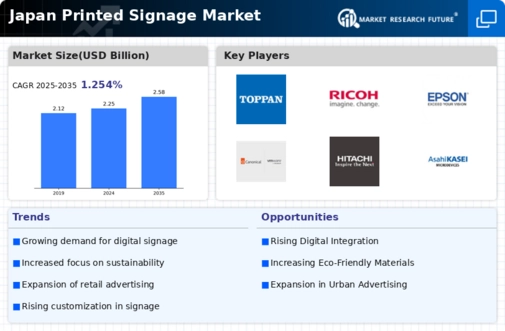Technological Advancements in Printing
The printed signage market in Japan is experiencing a notable transformation due to rapid technological advancements in printing techniques. Innovations such as digital printing and eco-friendly inks are enhancing the quality and efficiency of signage production. The adoption of advanced printing technologies allows for quicker turnaround times and reduced costs, which is particularly beneficial for businesses seeking to optimize their marketing strategies. Furthermore, the integration of automation in printing processes is likely to streamline operations, thereby increasing productivity. As a result, companies in the printed signage market are better positioned to meet the diverse needs of their clients, potentially leading to a growth rate of around 5% annually in the coming years.
E-commerce Growth and Retail Signage Needs
The growth of e-commerce in Japan is reshaping the retail landscape, which in turn impacts the printed signage market. As online shopping continues to gain traction, brick-and-mortar stores are compelled to enhance their physical presence through effective signage. Retailers are investing in high-quality printed signage to attract foot traffic and create a memorable shopping experience. This shift is likely to drive demand for innovative signage solutions that cater to the evolving needs of consumers. With e-commerce sales projected to grow by approximately 10% annually, the printed signage market is expected to benefit from this trend as retailers seek to differentiate themselves in a competitive environment.
Regulatory Compliance and Safety Standards
The printed signage market in Japan is influenced by stringent regulatory compliance and safety standards. Businesses are required to adhere to specific guidelines regarding signage visibility, legibility, and safety information. This regulatory environment necessitates the production of high-quality printed signage that meets these standards, thereby driving demand for specialized printing services. Companies that can provide compliant signage solutions are likely to gain a competitive edge in the market. Furthermore, as safety regulations evolve, the need for updated signage is expected to increase, potentially leading to a sustained growth trajectory for the printed signage market in Japan.
Urbanization and Infrastructure Development
Japan's ongoing urbanization and infrastructure development are significantly impacting the printed signage market. As cities expand and new commercial spaces emerge, the demand for effective signage solutions is likely to increase. This trend is particularly evident in metropolitan areas where businesses require eye-catching signage to attract customers. According to recent data, the construction sector in Japan is projected to grow by approximately 3% annually, which directly correlates with the rising need for printed signage. Additionally, public infrastructure projects, such as transportation systems and public spaces, are expected to further drive demand for high-quality signage, thereby creating opportunities for growth within the printed signage market.
Increased Marketing and Advertising Expenditure
In Japan, the rise in marketing and advertising expenditure is a crucial driver for the printed signage market. As businesses recognize the importance of effective branding and customer engagement, they are allocating more resources towards signage solutions. Recent statistics indicate that advertising spending in Japan is projected to reach approximately ¥6 trillion by 2026, which could lead to a corresponding increase in demand for printed signage. This trend suggests that companies are increasingly viewing signage as a vital component of their marketing strategies, thereby creating a favorable environment for growth within the printed signage market.























Leave a Comment